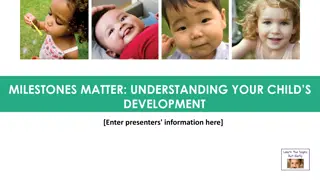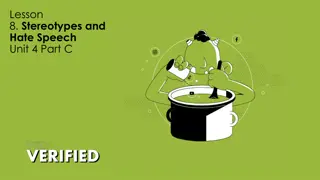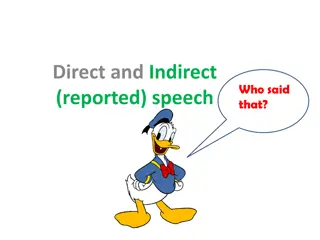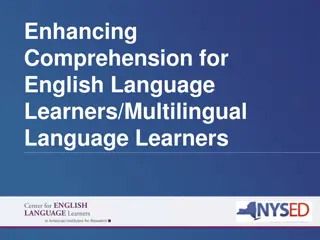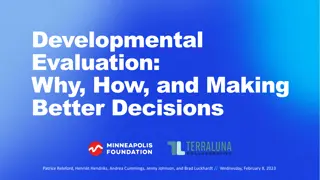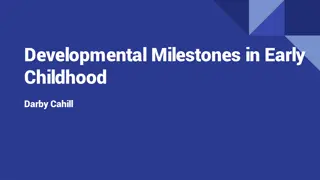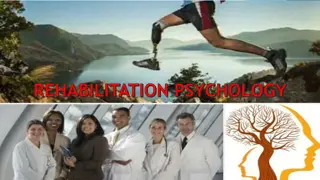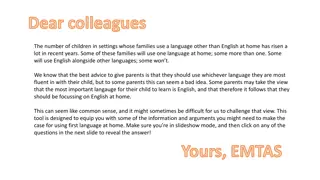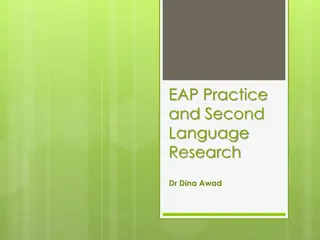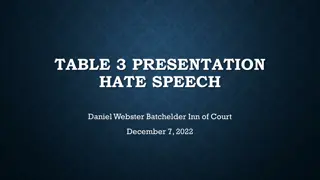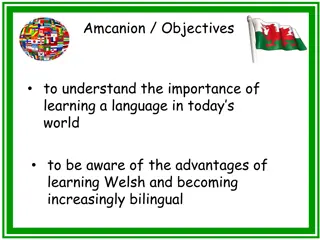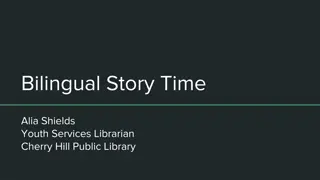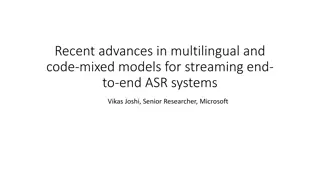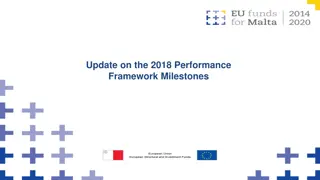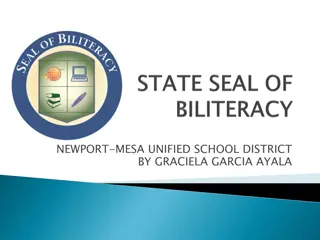Speech and Language Developmental Milestones: A Bilingual/Multilingual Perspective
Speech and language developmental milestones are crucial for children, regardless of their home language. These milestones encompass receptive language, expressive language, pragmatics, and articulation and phonology. Understanding how a child hears and talks from birth to one year is essential, as it includes key behaviors and responses indicative of their speech and language development. Emily Vincent, a speech-language pathologist, provides valuable insights into these milestones with a focus on bilingual and multilingual perspectives.
Download Presentation

Please find below an Image/Link to download the presentation.
The content on the website is provided AS IS for your information and personal use only. It may not be sold, licensed, or shared on other websites without obtaining consent from the author. Download presentation by click this link. If you encounter any issues during the download, it is possible that the publisher has removed the file from their server.
E N D
Presentation Transcript
SPEECH & LANGUAGE DEVELOPMENTAL MILESTONES: A BILINGUAL/MULTILINGUAL PERSPECTIVE EMILY VINCENT, MS CCC-SLP
I. SPEECH & LANGUAGE DEVELOPMENT *Milestones are expected for ALL children REGARDLESS of home language* Speech & Language Terminology Receptive language = language comprehension, hearing and understanding Expressive language = language production, language use either verbally (talking) or non-verbally (i.e. signing) Pragmatics = the use of language, social language; varied within languages and cultures Articulation & Phonology = the organization and production of specific sounds (phonemes), also known as speech or speech sound production EMILY VINCENT, MS CCC-SLP
HOW DOES YOUR CHILD HEAR AND TALK?* BIRTH-3 MONTHS Hearing and Understanding Talking Makes cooing sounds Startles to sounds Cries differently for different needs Quiets or smiles when you talk Smiles at people Seems to recognize your voice and quiets if crying Increases or decreases sucking behavior in response to sound *All information from asha.org https://identifythesigns.org/communicating-with-baby-toolkit/?utm_source=asha&utm_medium=email&utm_campaign=prbacktoschool EMILY VINCENT, MS CCC-SLP
HOW DOES YOUR CHILD HEAR AND TALK? 4-6 MONTHS Hearing and Understanding Talking Coos and babbles when playing alone or with you Moves eyes in direction of sounds Responds to changes in tone of your voice Makes speech-like babbling sounds, like pa, ba, and mi Notices toys that make sounds Giggles and laughs Pays attention to music Makes sounds when happy or upset EMILY VINCENT, MS CCC-SLP
HOW DOES YOUR CHILD HEAR AND TALK? 7 MONTHS-1 YEAR Hearing and Understanding Talking Babbles longer strings of sounds, such as mimi upup and babababa Plays games like peek-a-boo and pat-a-cake Points to objects and shows them to others Turns and looks in direction of sounds Looks when you point Uses gestures such as waving Recognizes words for familiar objects and people Has 1 or 2 words around first birthday, such as hi, dog, dada, mama, or uh-oh Turns to own name when you call Begins to respond to simple words and phrases, such as No and Come here Imitates different speech sounds Listens to songs and stories for a short time EMILY VINCENT, MS CCC-SLP
HOW DOES YOUR CHILD HEAR AND TALK? 1-2 YEARS Hearing and Understanding Talking Uses many new words Points to a few body parts when asked Uses p, b, m, h, and w in words Follows 1-part directions such as Roll the ball or Kiss the baby Starts to name pictures in books Asks what, who, and where questions, such as What s that? Who s that? and Where s kitty? Understands simple questions, like Who s that? and Where s your shoe? Puts 2 words together, such as more apple, no bed, and Mommy book Listens to stories, songs, and rhymes for a longer time Points to the pictures in books when you name them EMILY VINCENT, MS CCC-SLP
HOW DOES YOUR CHILD HEAR AND TALK? 2-3 YEARS Talking Hearing and Understanding Has a word for familiar people, places, things, and actions Understands opposite words, such as go-stop, big-little, and up-down Talks about things that are not in the room Follows two-part directions, such as Get the spoon and put it on the table Talks during pretend play, such as saying beep-beep when moving cars Understands new words quickly Uses k, g, f, t, d, and n in words Uses words like in, on, and under Asks why? Puts 3 words together to talk about and ask for things EMILY VINCENT, MS CCC-SLP
HOW DOES YOUR CHILD HEAR AND TALK? 3-4 YEARS Talking Answers simple who, what and where questions Hearing and Understanding Says rhyming words, such as hat-cat and silly-billy Responds when you call from another room Uses pronouns, such as I, you, me, we, and they Understands words for some colors, such as red, blue and green Uses some plural words, such as toys, birds, and buses Understands words for some shapes, such as circle and square Asks when and how questions Understands for for family, such as brother, grandmother, and aunt Puts 4 words together. May make some mistakes, such as I goed to school. Talks about what happened during the day. Uses about 4 sentences at a time EMILY VINCENT, MS CCC-SLP
HOW DOES YOUR CHILD HEAR AND TALK? 4-5 YEARS Hearing and Understanding Talking Says all speech sounds in words. May make mistakes on some sounds, such as l, s, r, v, z, j, ch, sh, and th Understands words for order, such as first, next, and last Understands words for time, such as yesterday, today, and tomorrow Names letters and numbers Tells a short story Follows longer directions, such as Get the box of crayons, find some paper, and pick out three colors Talks in different ways depending on the listener and place. Uses short sentences with younger children and talks louder outside than inside Understands most of what is said at home and at school Says most sounds correctly except a few like: l, s, r, z, j, ch, sh, th Uses the same grammar as the rest of the family EMILY VINCENT, MS CCC-SLP
SPEECH SOUND DEVELOPMENT DEPENDS ON LANGUAGES AND EXPOSURE In English EMILY VINCENT, MS CCC-SLP
HOW WELL SHOULD SOMEONE UNDERSTAND A CHILD S SPEECH? Speaking in short sentences to a non-familiar person, your child is understood: 3 year old: approximately 68% 3 1/2 year old: approximately 78% 4 year old: approximately 86% 4 1/2 year old: approximately 91% 5 year old: approximately 94% 6 year old: approximately 97% *https://www.boisechatterbox.com/blog/speech-sound-development-chart EMILY VINCENT, MS CCC-SLP
WIDELY SPOKEN LANGUAGE IN THE UNITED STATES Spanish, Chinese (Mandarin, Cantonese, Hokkien, etc), Tagalog (Filipino). Vietnamese, French & French Creole, Arabic, Korean, Russian and German https://bilinguistics.com/articulation-norms-for-spanish-and-English/ https://www.asha.org/siteassets/uploadedfiles/multicultural/mandarinphonemicinventory.pdf https://bilinguistics.com/filipino-tagalog-speech-sounds/ https://bilinguistics.com/vietnamese-speech-and-language-norms/ https://www.bonjourspeech.com/speech-sound-development https://www.asha.org/siteassets/uploadedfiles/multicultural/arabicphonemicinventory.pdf EMILY VINCENT, MS CCC-SLP
DUAL LANGUAGE LEARNERS: BILINGUALISM & MORE Being multilingual DOES NOT make speech and language development, delays, or disorders any slower or any more affected than being monolingual NEVER follow the advice to drop a language in the belief that it will simplify things, or support faster development in one language. There is NO SCIENTIFIC EVIDENCE to support this advice. Do not accept advice to drop a home language. That is your family, your culture, your life. That is not for anyone to take away. A dual language learner is NOT becoming a monolingual speaker in each of their langauges. Their languages communicate with each other in what is called processes of bilingualism. EMILY VINCENT, MS CCC-SLP
*Theholablog.com EMILY VINCENT, MS CCC-SLP
DUAL LANGUAGE LEARNERS Develop their early vocabulary at the same rate as monolingual children (Pearson, 1993) Have similar early language milestones (i.e. single words, lexical support, two-word phrases) (Pearson & Fernandez, 2001) Have similar conceptual scores (Pearson, 1998) 1 in 5 children in the U.S. speaks a language other than English in the home (2020 census) *From bilinguistics.com EMILY VINCENT, MS CCC-SLP
IF A DUAL LANGUAGE LEARNER HAS A TRUE LANGUAGE DELAY Bilingualism did NOT cause it They would have it, even if the family was monolingual Hearing many languages did NOT confuse them No need to stop bilingualism It is possible, they won t catch up with time Speech therapy will help Bilingualism will NOT harm their therapy progress @laleo.bilingual.therapy EMILY VINCENT, MS CCC-SLP
INDIVIDUALS WITH DISABILITIES EDUCATION ACT 2004 (MOST RECENT AMENDMENT 2015) The Individuals with Disabilities Education Act (IDEA) is a law that makes available a free appropriate public education to eligible children with disabilities throughout the nation and ensures special education and related services to those children. The IDEA governs how states and public agencies provide early intervention, special education, and related services to more than 7.5 million (as of school year 2020-21) eligible infants, toddlers, children, and youth with disabilities. Infants and toddlers, birth through age 2, with disabilities and their families receive early intervention services under IDEA Part C. Children and youth ages 3 through 21 receive special education and related services under IDEA Part B. https://sites.ed.gov/idea/about-idea/ EMILY VINCENT, MS CCC-SLP
IFSP: INDIVIDUAL FAMILY SERVICE/SUPPORT PLAN HTTPS://WWW.SPEECHBUDDY.COM/BLOG/LEGAL-ISSUES/WRITING-THE-INDIVIDUALIZED-FAMILY-SERVICE-PLAN-IFSP
IEP: INDIVIDUAL EDUCATION PLAN spedadvisor.com EMILY VINCENT, MS CCC-SLP
HOW ARE THE SERVICES PROVIDED? Part C IFSP Generally home-based, also to participate in early-childhood education center such as Early Head Start. Part B IEP Generally pull-out or classroom-based in local public elementary school in addition to Head Start. EMILY VINCENT, MS CCC-SLP
QUESTIONS? COMMENTS THANK YOU!! Follow on Instagram: @bilingualslpllc @bilingualplaydate @unlearnwithme.theslp @theholaclinic @laleo.bilingual.therapy @phuonglienpalafox @thecld_slp @jrc_theslp @code.switch.slp @aaefortheslp EMILY VINCENT, MS CCC-SLP
OTHER INFO SOURCES & CITATIONS https://www.theinformedslp.com/review/no-sl-ps-were-in-the-room- where-it- happened?fbclid=PAAaYVd2FoEUWvffRLQGjm5ffhQUm6hd7Ywbq T4in21i0hXGMQn2fahiqjVLc_aem_th_AZR86RvJMg5MQJqQlQGlT 1K86qtCF7tk9d3u8KWt5IWv16Xnl8W1DSevWVhD2xmCb1o https://identifythesigns.org/communicating-with-baby- toolkit/?utm_source=asha&utm_medium=email&utm_campaign=prb acktoschool EMILY VINCENT, MS CCC-SLP


